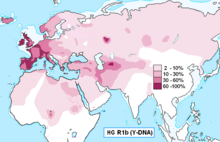Haplogroup R1b (Y-DNA)
| Haplogroup R1b | |
|---|---|
 |
|
| Possible place of origin | Western Asia |
| Ancestor | R1 |
| Descendants | One immediate descendant – R1b1 (L278, M415, P25). Three secondary descendants – R1b1a (R-M269); R1b1b (R-P297); R1b1c (R-V88) |
| Defining mutations | 1. M343 defines R1b in the broadest sense 2. In some cases, major downstream mutations such as M269 – which now defines R1b1a2 – are used to identify R1b, especially in regional or out-of-date studies. |
Haplogroup R1b (R-M343), known initially as Hg1 and Eu18, is a human Y-chromosome haplogroup.
It is the most frequently occurring paternal lineage in Western Europe, as well as some parts of Russia (e.g. the Bashkir minority) and Central Africa (e.g. Chad and Cameroon). R1b also reaches high frequencies in the Americas and Australasia, due largely to immigration from Western Europe. There is an ongoing debate regarding the origins of R1b subclades found at significant levels among some indigenous peoples of the Americas, such as speakers of Algic languages in central Canada. It is also present at lower frequencies throughout Eastern Europe, Western Asia, as well as parts of North Africa and Central Asia.
R1b has one primary branch, R1b1 (L278), which in turn has two primary branches: R1b1a (L75) and R1b1b (PH155). R1b1a is found mostly in Western Europe, although the Ful?e and Chadic-speaking peoples of Africa are dominated by R1b1a2 (PF6279/V88). Western Europe is dominated by the downstream subclades of R1b1a – especially R1b1a1a2 (R-M269), previously known as R1b1a2. R1b1b (PH155) is seen mostly in Western and Central Asia.
R1b is a subclade within the "macro-haplogroup" Haplogroup K (K-M9), which is one of the predominant groupings of all the rest of human male lines outside of Africa. K* is believed to have originated in Asia (as is the case with an even earlier ancestral haplogroup, F (F-M89). Karafet T. et al. (2014) "rapid diversification process of K-M526 likely occurred in Southeast Asia, with subsequent westward expansions of the ancestors of haplogroups R and Q."
...
Wikipedia
